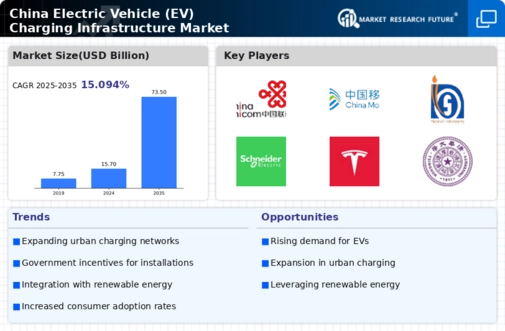Market Growth Projections
The Global China Electric Vehicle EV Charging Infrastructure Market Industry is poised for substantial growth, with projections indicating a market size of 25 USD Billion in 2024 and a remarkable increase to 120 USD Billion by 2035. This growth trajectory suggests a compound annual growth rate of 15.33 percent from 2025 to 2035, reflecting the increasing demand for electric vehicles and the corresponding need for charging infrastructure. The expansion of charging networks is essential to support the anticipated rise in EV adoption, driven by factors such as government policies, technological advancements, and changing consumer preferences. This market growth underscores the importance of strategic investments and planning in the EV charging sector.
Technological Advancements
Technological advancements play a pivotal role in the evolution of the Global China Electric Vehicle EV Charging Infrastructure Market Industry. Innovations such as ultra-fast charging stations and smart grid technology enhance the efficiency and convenience of charging solutions. For example, the development of 350 kW charging stations allows for rapid charging, significantly reducing downtime for EV users. These advancements not only improve user experience but also encourage the expansion of charging networks across urban and rural areas. As technology continues to evolve, it is anticipated that the market will experience a compound annual growth rate of 15.33 percent from 2025 to 2035, reflecting the increasing integration of advanced technologies.
Investment from Private Sector
Investment from the private sector is a significant driver of the Global China Electric Vehicle EV Charging Infrastructure Market Industry. Major corporations and startups are increasingly recognizing the potential of the EV market and are investing in charging solutions. This influx of capital facilitates the development of innovative charging technologies and the expansion of charging networks. Companies are forming partnerships to enhance the availability of charging stations in strategic locations, thereby improving accessibility for EV users. As the market matures, private sector investment is likely to play a crucial role in shaping the future landscape of charging infrastructure, further propelling growth in the industry.
Rising Environmental Awareness
Rising environmental awareness among consumers and businesses is a driving force behind the Global China Electric Vehicle EV Charging Infrastructure Market Industry. As concerns about air pollution and climate change intensify, there is a growing shift towards sustainable transportation solutions. This shift is reflected in the increasing sales of electric vehicles, which necessitate a corresponding expansion of charging infrastructure. The Chinese government has recognized this trend and is investing heavily in charging networks to support the transition to greener alternatives. By 2035, the market is projected to reach 120 USD Billion, underscoring the potential for growth driven by environmental considerations.
Government Policies and Incentives
The Global China Electric Vehicle EV Charging Infrastructure Market Industry is significantly influenced by robust government policies and incentives aimed at promoting electric vehicle adoption. The Chinese government has implemented various subsidies and tax incentives for EV buyers, which in turn stimulates the demand for charging infrastructure. For instance, the government has set ambitious targets for EV penetration, aiming for 20 percent of all new vehicle sales to be electric by 2025. This regulatory environment is expected to propel the market, with projections indicating that the market could reach 25 USD Billion in 2024, highlighting the critical role of government support in shaping the industry.
Urbanization and Population Growth
Urbanization and population growth are critical factors influencing the Global China Electric Vehicle EV Charging Infrastructure Market Industry. As more people migrate to urban areas, the demand for efficient transportation solutions escalates. This urban influx necessitates the development of comprehensive charging networks to accommodate the increasing number of electric vehicles. Cities are investing in public charging stations to ensure accessibility for residents and visitors alike. The expansion of charging infrastructure is essential to support the anticipated growth in EV adoption, which is expected to be substantial in the coming years. This trend indicates a robust market potential as urban centers evolve to meet the needs of their populations.








